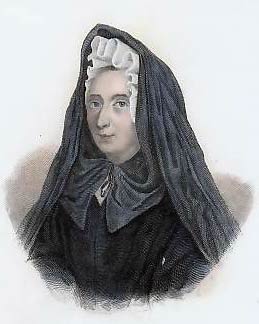Readings:
This commemoration is a 2018 addition to A Great Cloud of Witnesses.
Return to Lectionary Home Page
Webmaster: Charles Wohlers
Last updated: 6 May 2019
JEANNE GUYON
MYSTIC, 1717
 Jeanne-Marie Bouvier de la Motte-Guyon (commonly known as Madame Guyon, 13 April 1648 – 9 June 1717) was a French mystic and was accused of advocating Quietism, although she never called herself a Quietist. Quietism was considered heretical by the Roman Catholic Church, and she was imprisoned from 1695 to 1703 after publishing the book A Short and Very Easy Method of Prayer.
Jeanne-Marie Bouvier de la Motte-Guyon (commonly known as Madame Guyon, 13 April 1648 – 9 June 1717) was a French mystic and was accused of advocating Quietism, although she never called herself a Quietist. Quietism was considered heretical by the Roman Catholic Church, and she was imprisoned from 1695 to 1703 after publishing the book A Short and Very Easy Method of Prayer.
In 1664, when she was 15 years old, after turning down many other proposals, she was forced into an arranged marriage to a wealthy gentleman of Montargis, Jacques Guyon, aged thirty eight. During her twelve years of marriage, Guyon suffered terribly at the hands of her mother-in-law and maidservant. Adding to her misery were the deaths of her half-sister, followed by her mother, and her son. Her daughter and father then died within days of each other in July 1672. Guyon retained belief in God's perfect plan and that she would be blessed in suffering. After twelve years of an unhappy marriage (in which she had borne five children, of whom three had survived), Madame Guyon had become a widow at the age of 28.
During her marriage, Guyon became introduced to mysticism by Fr. François La Combe, a Barnabite, and was instructed by him.
After a third mystical experience in 1680, Madame Guyon felt herself drawn to Geneva. However, because of the effects her mystical ideas produced, the Bishop of Geneva, D'Aranthon d'Alex, who had at first viewed her coming with pleasure, asked her to leave his diocese, and at the same time he expelled Father Lacombe, who was then appointed Bishop of Vercelli.
Madame Guyon followed her director to Turin, then returned to France and stayed at Grenoble, where she spread her religious convictions more widely with the publication of "Moyen court et facile de faire oraison" in January 1685. The Bishop of Grenoble, Cardinal Le Camus, was perturbed by the appeal her ideas aroused and she left the city at his request, rejoining Lacombe at Vercelli. In July the following year the pair returned to Paris, where Madame Guyon set about to gain adherents for her mystical vision. The timing was ill-chosen; Louis XIV, who had recently been exerting himself to have the Quietism of Molinos condemned at Rome, was by no means pleased to see gaining ground, even in his own capital, a form of mysticism which, to him, resembled that of Molinos in many of its aspects. By his order Lacombe was shut up in the Bastille, and afterwards in the castles of Oloron and of Lourdes.
She was not released until seven months later, after she had placed in the hands of the theologians, who had examined her book, a retraction of the propositions which it contained. Some days later she met François Fénelon, who was to be the most famous of her disciples. She won him by her piety and her understanding of the paths of spirituality.
Through Fénelon the influence of Madame Guyon reached and influenced religious circles powerful at court. Before long, however, the Bishop of Chartres took alarm at the spiritual ideas which were spreading there. Warned by him, Madame de Maintenon sought the advice of persons whose piety and wisdom she valued, and these advisers were unanimous in their rejection of Madame Guyon's ideas. Madame Guyon then asked for an examination of her conduct and her writings by civil and ecclesiastical judges. Madame Guyon was arrested on 24 December 1695 and imprisoned, eventually in the Bastille, where on 23 August 1699 she again signed a retraction of her theories and promised to refrain from spreading them further. From that time on she took no part, personally, in public discussions, but the controversy about her ideas only grew.
Madame Guyon remained imprisoned in the Bastille until 21 March 1703, when, after more than seven years of her final captivity, she went to live with her son in a village in the Diocese of Blois. There she passed some fifteen years surrounded by a stream of pilgrims, many from England and Scotland, and spending her time writing volumes of correspondence and poetry.
She died at the age of 69, in Blois, believing that she had died submissive to the Catholic Church, from which she had never had any intention of separating herself.
Her published works, the Moyen Court and the Règles des associées à l'Enfance de Jésus, were both placed on the Index Librorum Prohibitorum (a list of texts Roman Catholics were forbidden to read) in 1688.
more at Wikipedia
Many of her works are available from the Internet Archive, nearly all in the original French only.